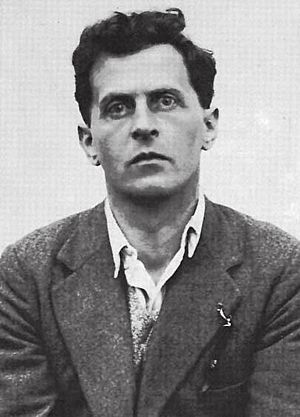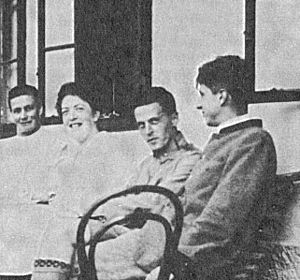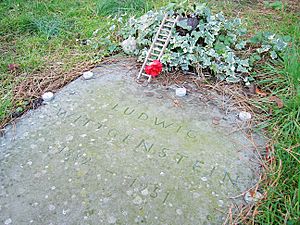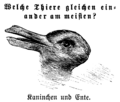Ludwig Wittgenstein facts for kids
Quick facts for kids
Ludwig Wittgenstein
|
|
|---|---|

Portrait of Wittgenstein on being awarded a scholarship from Trinity College, Cambridge, 1929
|
|
| Born |
Ludwig Josef Johann Wittgenstein
26 April 1889 |
| Died | 29 April 1951 (aged 62) |
| Nationality | Austrian |
| Education |
|
|
Notable work
|
Tractatus Logico-Philosophicus Philosophical Investigations |
| Era | 20th-century philosophy |
| Region | Western philosophy |
| School | Analytic philosophy Linguistic turn Logical atomism Logical behaviorism Correspondence theory of truth |
| Institutions | Trinity College, Cambridge |
|
Main interests
|
Logic, metaphysics, philosophy of language, philosophy of mathematics, philosophy of mind, epistemology |
|
Notable ideas
|
Picture theory of language Truth functions States of affairs Logical necessity Use theory of meaning Language-games Private language argument Family resemblance Rule following Forms of life Wittgensteinian fideism Wittgenstein's philosophy of mathematics Ordinary language philosophy Ideal language analysis Wittgenstein's ladder Quietism Seeing-as Depth and Surface grammar |
|
Influences
|
|
|
Influenced
|
|
Ludwig Josef Johann Wittgenstein (born April 26, 1889 – died April 29, 1951) was an important Austrian philosopher. He focused on the basics of logic, the philosophy of mathematics, how our minds work, and how we use language. Many people see him as one of the most important thinkers of the 1900s.
Before he passed away at 62, Wittgenstein had only published one book, called Tractatus Logico-Philosophicus. His second major book, Philosophical Investigations, came out soon after his death. Both books are considered very important in a field of study called analytic philosophy.
Contents
Ludwig Wittgenstein's Life
Ludwig Wittgenstein was born in Vienna, Austria, on April 26, 1889. He was the youngest of eight children. His family was one of the richest and most well-known in the Austro-Hungarian empire.
His father, Karl Wittgenstein, became very wealthy from iron and steel. Ludwig's mother, Leopoldine, was an aunt of the famous economist Friedrich von Hayek. Even though his father was Protestant and his mother's father was Jewish, the Wittgenstein children were raised as Roman Catholics.
Early Studies and Philosophy
Wittgenstein first started studying mechanical engineering. While doing this, he became very interested in the basic ideas behind mathematics. He especially liked the books Principles of Mathematics by Bertrand Russell and Grundgesetze by Gottlob Frege.
In 1911, Wittgenstein met Frege and Russell. He talked about philosophy with them for a long time. Russell was very impressed by Wittgenstein. Soon, Wittgenstein began working on the foundations of logic and mathematical logic. Russell even thought Wittgenstein would continue his own work.
The Tractatus Book
During World War I, Wittgenstein served in the army. While in the army, he kept working on his ideas about logic. He also started to include ideas about ethics, which is the study of right and wrong.
In 1918, he learned that his friend David Pinsent had died in a plane crash. This made Wittgenstein very sad. He went to stay with his uncle, where he finished his book, the Tractatus.
At first, no publisher wanted to print it. But Russell knew it was an important book for philosophy. He wrote an introduction for it. Wittgenstein didn't like Russell's introduction because he felt Russell didn't truly understand the book. Finally, a German edition was printed in 1921, and a bilingual English-German edition came out in 1922.
After the Tractatus
Wittgenstein believed that his Tractatus had solved all the big problems in philosophy. So, he decided to leave philosophy. He went back to Austria to become a primary school teacher.
He had very high expectations for the children he taught in the countryside. He was not very patient with kids who struggled with math. However, he got good results with students who were interested, especially boys. His strict teaching style caused problems with some parents. Eventually, he quit his job, feeling like he had failed as a teacher.
After teaching, Wittgenstein worked as a gardener's helper at a monastery. Then, he worked with an architect named Paul Engelmann. This intellectual work helped him feel better.
Between 1925 and 1928, he helped his sister Margaret build a house in Vienna. Wittgenstein and Paul Engelmann designed it together. This house, called 'Haus Wittgenstein', is still standing in Vienna today.
Near the end of this project, Moritz Schlick contacted Wittgenstein. Schlick was a key person in a new group of thinkers called the Vienna Circle. This contact made Wittgenstein interested in philosophy again.
Return to Cambridge
In 1929, Wittgenstein decided to go back to Cambridge, England. When he arrived at the train station, many of England's most famous thinkers were there to meet him. He was surprised to find out he was now one of the most famous philosophers in the world.
In 1939, Wittgenstein was given a special job as a professor of Philosophy at Cambridge.
During World War II, he left Cambridge. He volunteered to work as a hospital porter (someone who helps patients) in London. He also worked as a lab assistant in Newcastle upon Tyne.
Final Years and Legacy
Wittgenstein left his teaching job at Cambridge in 1947. He wanted to spend all his time writing. In 1949, he found out he had prostate cancer. By then, he had written most of the ideas for his book Philosophical Investigations. This book is often seen as his most important work.
He died from prostate cancer in Cambridge in 1951.
Images for kids
-
From left, Helene, Rudi, Hermine, Ludwig (the baby), Gretl, Paul, Hans, and Kurt, around 1890
-
The Realschule in Linz
-
Austrian philosopher Otto Weininger (1880–1903)
-
The old Technische Hochschule Berlin in Charlottenburg, Berlin
-
Ludwig with his friend William Eccles at the Kite-Flying Station in Glossop, Derbyshire
-
Bertrand Russell, 1907
-
Entries from October 1914 in Wittgenstein's diary, on display at the Wren Library, Trinity College, Cambridge
-
Austro-Hungarian supply line over the Vršič Pass, on the Italian front, October 1917
-
The Wittgenstein family in Vienna, Summer 1917, with Kurt (furthest left) and Ludwig (furthest right) in officers' uniforms.
-
Ludwig Wittgenstein, schoolteacher, c. 1922
-
Frank P. Ramsey visited Wittgenstein in Puchberg am Schneeberg in September 1923.
-
Photograph showing Wittgenstein's house in Norway, sent by Wittgenstein to G. E. Moore, October 1936
-
Wittgenstein in the Fellows' Garden at Trinity, 1939
-
Wittgenstein in Swansea, Summer 1947
-
One of the last photographs taken of Wittgenstein, in the garden of Georg Henrik von Wright's home in Cambridge, Summer 1950; Wittgenstein had taken the sheet from his bed and draped it behind him
-
Plaque in the National Botanic Gardens, Dublin, commemorating Wittgenstein's visits in the winter of 1948–1949.
-
Wittgenstein's grave at the Ascension Parish Burial Ground in Cambridge
-
Illustration of a "duckrabbit", discussed in the Philosophical Investigations, section XI, part II
See also
 In Spanish: Ludwig Wittgenstein para niños
In Spanish: Ludwig Wittgenstein para niños





































